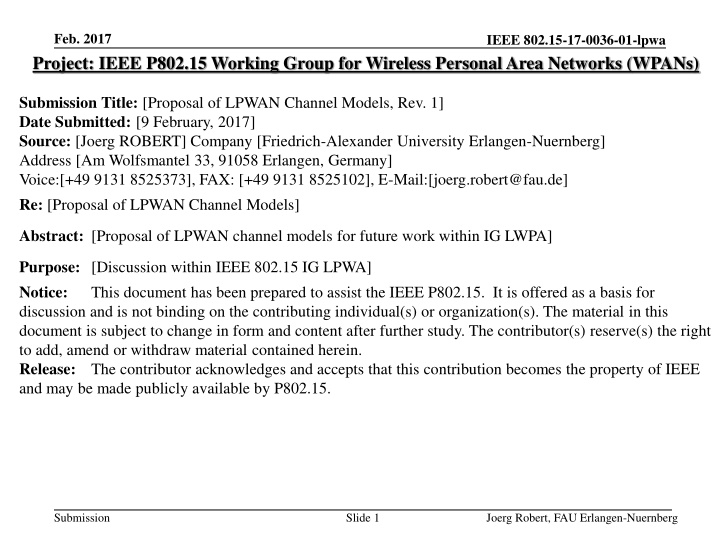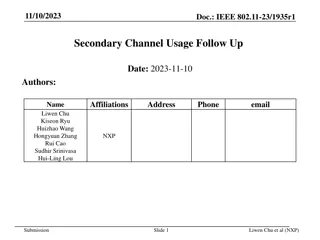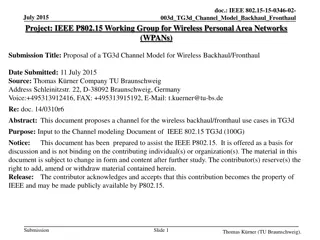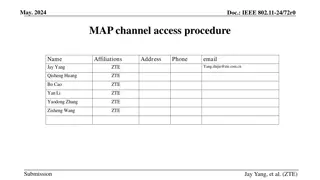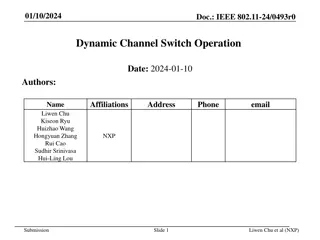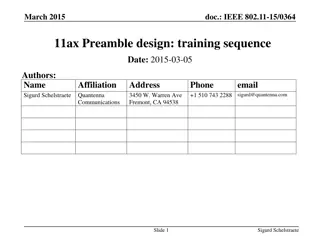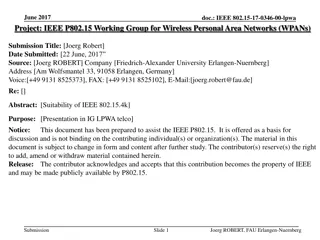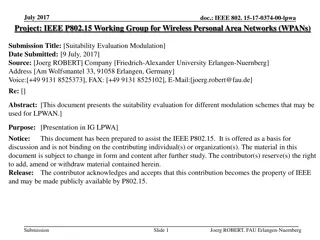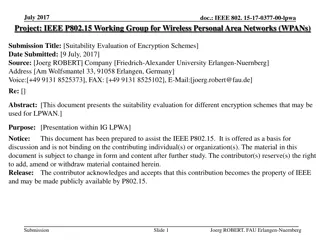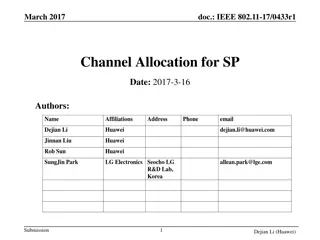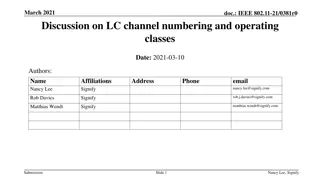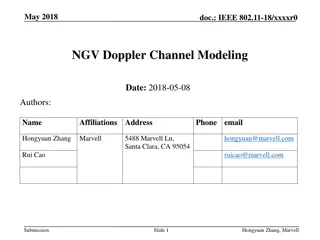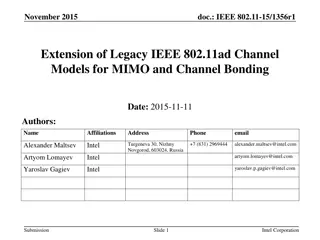Proposal of LPWAN Channel Models for Future Work within IEEE 802.15
Proposal of LPWAN channel models for future work within IEEE 802.15 Working Group, focusing on different classes and technology options, adaptation of IEEE 802.11ah channel models, basic channel model structure, noise effects, multi-path propagation, and system performance evaluation.
Download Presentation

Please find below an Image/Link to download the presentation.
The content on the website is provided AS IS for your information and personal use only. It may not be sold, licensed, or shared on other websites without obtaining consent from the author.If you encounter any issues during the download, it is possible that the publisher has removed the file from their server.
You are allowed to download the files provided on this website for personal or commercial use, subject to the condition that they are used lawfully. All files are the property of their respective owners.
The content on the website is provided AS IS for your information and personal use only. It may not be sold, licensed, or shared on other websites without obtaining consent from the author.
E N D
Presentation Transcript
Feb. 2017 Project: IEEE P802.15 Working Group for Wireless Personal Area Networks (WPANs) IEEE 802.15-17-0036-01-lpwa Submission Title: [Proposal of LPWAN Channel Models, Rev. 1] Date Submitted: [9 February, 2017] Source: [Joerg ROBERT] Company [Friedrich-Alexander University Erlangen-Nuernberg] Address [Am Wolfsmantel 33, 91058 Erlangen, Germany] Voice:[+49 9131 8525373], FAX: [+49 9131 8525102], E-Mail:[joerg.robert@fau.de] Re: [Proposal of LPWAN Channel Models] Abstract: [Proposal of LPWAN channel models for future work within IG LWPA] Purpose: [Discussion within IEEE 802.15 IG LPWA] Notice: This document has been prepared to assist the IEEE P802.15. It is offered as a basis for discussion and is not binding on the contributing individual(s) or organization(s). The material in this document is subject to change in form and content after further study. The contributor(s) reserve(s) the right to add, amend or withdraw material contained herein. Release: The contributor acknowledges and accepts that this contribution becomes the property of IEEE and may be made publicly available by P802.15. Submission Slide 1 Joerg Robert, FAU Erlangen-Nuernberg
Feb. 2017 IEEE 802.15-17-0036-01-lpwa Revised LPWAN Channel Models Joerg Robert FAU Erlangen-Nuernberg Submission Slide 2 Joerg Robert, FAU Erlangen-Nuernberg
Feb. 2017 IEEE 802.15-17-0036-01-lpwa Motivation Four different classes proposed in use-case document [2] Indoor, Outdoor Urban, Outdoor Rural, Satellite Comparison of different technology options requires definition of channel models Proposal: Use subset of IEEE 802.11ah channel models [1] and adapt where required 11ah has been developed for 900 MHz operation Submission Slide 3 Joerg Robert, FAU Erlangen-Nuernberg
Feb. 2017 IEEE 802.15-17-0036-01-lpwa Basic Channel Model Structure ( I / II ) ? ? = ? ? ??(?) ? + ? ? + ?(?) ?(?) is the transmitted, and ?(?) the received signal Path loss ??(?) Attenuation of the signal, only affects the received signal level Multi-path (?) Effects due to time-variant multi-path propagation Results in frequency and time dispersive channel Requires convolution with the input signal Submission Slide 4 Joerg Robert, FAU Erlangen-Nuernberg
Feb. 2017 IEEE 802.15-17-0036-01-lpwa Basic Channel Model Structure ( II / II ) Noise ?(?) Thermal noise (given by -174dBm/Hz and noise figure of the receiver) Interference ?(?) Effects due to other systems using the same frequency band Will be discussed in extra document The performance of a system is evaluated using thousands of simulation runs A new channel model realization is calculated for each simulation run Submission Slide 5 Joerg Robert, FAU Erlangen-Nuernberg
Feb. 2017 IEEE 802.15-17-0036-01-lpwa Indoor Path-Loss Model ( I / II ) Use of model A defined for 11ah [1, sec. 3.5]: 4???? ?0 for ? ??? ?? ? = 20log10 ? ??? for ? > ??? ?? ? = ?? ??? + 35log10 where dBP, d, fc, and c0 are the breakpoint in m, the distance in m, the carrier frequency set to 900MHz, and the speed of light. dBP[m] Slope before dBP Slope after dBP Shadow fading [dB] before dBP Shadow fading [dB] after dBP 5 2 3.5 2 3 The above formulas only represent the median path loss Deviation around the median is model by adding a random Gaussian variable with zero mean and standard deviation in dB Additional parameters such as floor index should not be used Submission Slide 6 Joerg Robert, FAU Erlangen-Nuernberg
Feb. 2017 IEEE 802.15-17-0036-01-lpwa Indoor Path-Loss Model ( II / II ) Submission Slide 7 Joerg Robert, FAU Erlangen-Nuernberg
Feb. 2017 IEEE 802.15-17-0036-01-lpwa Indoor Multi-Path Model Similar to model A defined for 11ah [1, sec. 3.4] Single tap only as short RMS delay spread will not lead to relevant frequency selectivity within typical LPWAN bandwidth Modeling of Doppler component according to [3, sec. 4.7.1] with ? = 1.2km/h and ?0= 900MHz Submission Slide 8 Joerg Robert, FAU Erlangen-Nuernberg
Feb. 2017 IEEE 802.15-17-0036-01-lpwa Outdoor Urban Model Use of the 3GPP Spatial Channel model scenario Urban Macro [4, sec. 5] Similar approach followed by 11ah [1, sec. 3.2] Model defines path-loss and multi-path for base-stations with exposed antennas and a typical distance of 3km Additional parameters Frequency set to f=900MHz Speed set to v=3km/h Use of single polarization only Submission Slide 9 Joerg Robert, FAU Erlangen-Nuernberg
Feb. 2017 IEEE 802.15-17-0036-01-lpwa Outdoor Rural Model Use of the 3GPP Spatial Channel model scenario Suburban Macro [4, sec. 5] Similar approach followed by 11ah [1, sec. 3.2] Model defines path-loss and multi-path for base-stations with exposed antennas and a typical distance of 3km Additional parameters Frequency set to f=900MHz Speed set to v=3km/h Use of single polarization only Submission Slide 10 Joerg Robert, FAU Erlangen-Nuernberg
Feb. 2017 IEEE 802.15-17-0036-01-lpwa Outdoor Device-to-Device Model potentially required for comparison with multi-hop structures Use of 11ah device to device model [1, sec. 3.3] Effects due to multi-path should not be considered where d is in m and ??= 900MHz is assumed ?? ? = 6.17 + 58.6 log10? Deviation around the median path loss ??(?) is model by adding a random Gaussian variable with zero mean and a standard deviation of 7.5 Submission Slide 11 Joerg Robert, FAU Erlangen-Nuernberg
Feb. 2017 IEEE 802.15-17-0036-01-lpwa Noise Figure ? = 3dB for base-stations ? = 6dB for nodes Submission Slide 12 Joerg Robert, FAU Erlangen-Nuernberg
Feb. 2017 IEEE 802.15-17-0036-01-lpwa Mobility for Outdoor Models Stationary Device does not move Channel model assumes Doppler of 3km/h to consider movements in surrounding environment Pedestrian Multi-path channel model assumes 3km/h Urban Multi-path channel model assumes 30km/h High speed Multi-path channel model assumes 120km/h Submission Slide 13 Joerg Robert, FAU Erlangen-Nuernberg
Feb. 2017 IEEE 802.15-17-0036-01-lpwa Literature [1] IEEE 802.11 TGah Channel Model, IEEE 802.11-11/968r4 [2] Potential Use-Cases for LPWA, IEEE 802.15-16/770r2 [3] IEEE 802.11 TGn Channel Model, IEEE 802.11-03/940r4 [4] Spatial channel model for Multiple Input Multiple Output (MIMO) simulations (Release 13), 3GPP TR 25.996, V13.0.0, Dec. 2015 Submission Slide 14 Joerg Robert, FAU Erlangen-Nuernberg
